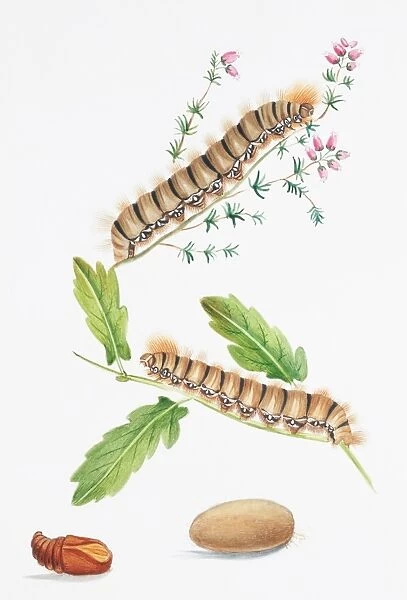Home > Animals > Insects > Butterflies > Lappet Moth
Lasiocampa quercus, oak eggar moth
![]()

Wall Art and Photo Gifts from Mary Evans Picture Library
Lasiocampa quercus, oak eggar moth
Plate 49 from Larvae and Pupae of British Lepidoptera (1878) by Theo Johnson
Mary Evans Picture Library makes available wonderful images created for people to enjoy over the centuries
Media ID 8589857
© Mary Evans Picture Library 2015 - https://copyrighthub.org/s0/hub1/creation/maryevans/MaryEvansPictureID/10708822
Arthropod Arthropoda Caterpillar Cocoon Eggar Eudicot Eurosid Fabidae Fagaceae Fagales Hexapod Hexapoda Insecta Johnson Lasiocampa Angiospermae Dicot Dicotyledon Invertebrata Lasiocampidae
EDITORS COMMENTS
Plate 49 from Larvae and Pupae of British Lepidoptera (1878) by Theo Johnson showcases an intricately detailed illustration of the Oak Eggar Moth, Lasiocampa quercus, in its cocoon stage. This beautiful arthropod is a member of the Lasiocampidae family, also known as the Lappet Moths, which are characterized by their distinctive, large, pad-like larval hindguts, or lappets. The Oak Eggar Moth is native to Europe, North Africa, and western Asia. It is commonly found in woodlands and forests, particularly those dominated by oak trees (Fagaceae), its primary food source. The caterpillars of this moth feed on the leaves of various oak species (Quercus spp.), while the adults feed on nectar from a variety of flowers. The illustration reveals the intricacies of the Oak Eggar Moth's cocoon, which is brown and roughly spherical in shape. The cocoon is covered in a fine, silky texture, which provides protection for the developing pupa inside. The metamorphosis from caterpillar to adult moth is a remarkable transformation, characterized by the shedding of the old exoskeleton and the emergence of wings. The Oak Eggar Moth is an essential component of the biodiversity of the forests it inhabits. Its larvae play a crucial role in the ecosystem by contributing to the breakdown of oak leaves and recycling nutrients back into the soil. The adult moths, with their distinctive markings and elegant wings, are an important food source for various predators, including birds and spiders. This stunning illustration by Theo Johnson not only captures the beauty and intricacy of the Oak Eggar Moth but also highlights the important role that invertebrates, such as moths, play in the complex web of life. The illustration is a testament to the artistry and scientific accuracy of the Victorian era's natural history recordings.
MADE IN THE UK
Safe Shipping with 30 Day Money Back Guarantee
FREE PERSONALISATION*
We are proud to offer a range of customisation features including Personalised Captions, Color Filters and Picture Zoom Tools
SECURE PAYMENTS
We happily accept a wide range of payment options so you can pay for the things you need in the way that is most convenient for you
* Options may vary by product and licensing agreement. Zoomed Pictures can be adjusted in the Basket.

